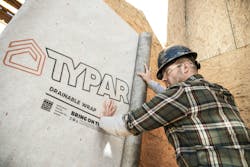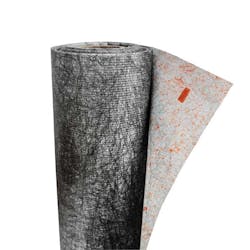Drainable Building Wraps Provide Weather Protection Solution for Heavy Rain Areas
As a general rule, the Building Enclosure Moisture Management Institute recommends that any area receiving more than 20 inches of annual rainfall should incorporate enhanced drainage techniques in the wall system, especially if using an absorptive cladding material. Areas receiving more than 40 inches of rain should utilize rainscreen design regardless of cladding material. The geographic orientation of the wall, amount of overhang, altitude, and even nearby trees can also have an impact on how much water intrusion can be expected and how likely it is to dry.
Some states have added prescriptive measures to their codes that now include the use of drainage planes, and others are expected to follow. Oregon, for example, requires that the building envelope consist of an exterior veneer, a water-resistive barrier, a minimum 1/8” (3 mm) space between the WRB and the exterior veneer, and integrated flashings. The envelope must provide proper integration of flashings with the water-resistive barrier, the space provided, and the exterior veneer. In lieu of providing the 1/8” space between the exterior veneer and the water-resistive barrier, builders can install the exterior veneer over a water-resistive barrier that is manufactured to enhance drainage and meets the 75% drainage efficiency requirement of ASTM E2273 or other recognized national standards.
These considerations are driving the adoption of new WRB solutions that meet both bulk water blockage and drainage needs that satisfy the requirements for today’s high-performing wall systems. At the cutting edge of drainable building wrap technology are products that create a drainage gap through an additional layer of polypropylene fibers. TYPAR Drainable Wrap™, for example, uses this technology to create a 1 mm drainage gap and has been shown to achieve 94.8 percent drainage efficiency per ASTM E2273 without sacrificing any of the durability and ease of installation benefits builders and contractors have come to expect from premium building wraps, since it essentially handles and installs the same as a standard TYPAR building wrap. In addition, it is backed by an industry-leading lifetime-limited warranty that includes both materials and labor.
Like dimpled wraps, these products can also be installed in any direction without affecting performance. And they are vapor permeable, so moisture will not become trapped in the wall assembly and lead to mold or rot issues.
While we can’t completely stop water from getting into walls, advances in building wrap technology are a welcome way to help ensure potential damage from water intrusion is mitigated. And with a variety of drainable products to choose from, builders and contractors have many ways to keep walls dry in any climate or condition.
About the Author

Bijan Mansouri, TYPAR
Bijan Mansouri is the technical manager at TYPAR Construction Products. He has been with Berry Plastics for more than 25 years working in different technical capacities. He is responsible for Building code requirements, designing and development of new construction products, training builders and architects on application of new and existing products and creating and education on the proper practice and installation of building envelope. He can be reached at [email protected].

